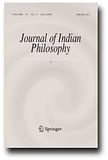Journal of Indian Philosophy 2011 - 39,2
Verfasst von pw am Mo, 07/25/2011 - 22:23.
Journal of Indian Philosophy
Journal of Indian philosophy / Editor-in-Chief: Phyllis Granoff. - Vol. 39,2. - Dordrecht [u.a.] : Springer [u.a.], 2011.
ISSN 0022-1791 (Printausg.)
ISSN 1573-0395 (Online-Ausg.)
URL: Homepage
URL: Online-Ausg. (Springerlink)
Inhalt: 39,2 (2011)
Som Dev Vasudeva: Haṃsamiṭṭhu: “Pātañjalayoga is Nonsense”. - In: JIP. - 39,2 (2011), S. 123-145
DOI: 10.1007/s10781-010-9107-7
DOI: 10.1007/s10781-010-9107-7
Abstract: The ninth chapter of the Haṃsavilāsa of the Gujarati Śaiva author Haṃsamiṭṭhu (born 1738 ad) argues that Pātañjalayoga, conceived of as a conflation of Aṣṭāṅgayoga and Haṭhayoga, cannot be valid soteriology. Pātañjalayoga is presented as a paradoxical and painful attempt to achieve quiescence by forcibly eliminating karma. Haṃsamiṭṭhu, conversely, views ‘euphoria’ (ullāsa) as a prerequisite for liberation, and therefore advocates a painless method of Rājayoga. This is taught as a Śaiva form of the Rāsalīlā involving transgressive substances and behaviour. A frame story establishes Haṃsamiṭṭhu’s authority to teach such practices by revealing his secret identity as Haṃsa, a favored companion of Śiva who incarnates for a single life to promulgate esoteric teachings. The purity of this Rāsalīlā is defended by challenging the validity of a conventional morality that seeks to portray it as abhorrent.
Tsering Wangchuk: In Defense of His Guru: Dratsepa’s Rebuttal to the Challenges Articulated by the Proponents of the Other-Emptiness Doctrine. - In: JIP. - 39,2 (2011), S. 147-165
DOI: 10.1007/s10781-010-9120-x
DOI: 10.1007/s10781-010-9120-x
Abstract: The buddha-nature literature has a significant place within the Indian Mahāyāna tradition and Tibetan Buddhism. While it is usually included in the so-called Last Wheel of the Buddha’s teachings, many Tibetan thinkers began to cast doubts about the textual significance of buddha-nature discourse in fourteenth-century Tibet. In this article, I will examine one particular case where there is apparent tension between multiple Tibetan masters over the importance of buddha-nature teachings. This paper primarily analyzes Dratsepa’s commentary to the Ornament (mdzes rgyan) written by his teacher, Buton. Dratsepa construes the Ornament as a work critiquing Dolpopa’s interpretation of the buddha-nature literature. He levels a barrage of criticisms against Dolpopa by referring to Indian śāstras and sūtras that are equally important to both of them, and also by tracing his own assessment of the tathāgata-essence teachings to early Tibetan scholars. In contradistinction to Dolpopa’s claims, Dratsepa offers several nuanced readings of the buddha-nature literature and complicates the notion of what it means to have tathāgata-essence, what a definitive or provisional meaning entails, and the relationship between the Middle Wheel and the Last Wheel teachings. In brief, Dratsepa’s text sheds light on one of the earliest discourses on the tension between self-emptiness and other-emptiness presentations.
Ramkrishna Bhattacharya: Two Obscure Sanskrit Words Related to the Cārvāka: pañcagupta and kuṇḍakīṭa. - In: JIP. - 39,2 (2011), S. 167-171
DOI: 10.1007/s10781-010-9122-8
DOI: 10.1007/s10781-010-9122-8
Abstract: Two words, pañcagupta and kuṇḍakīṭa, are found in modern Sanskrit lexicons such as the Śabdakalpadruma, the Vācaspatya, the Sanskrit-Wörterbuch, and A Sanskrit English Dictionary. They are said to signify the Cārvāka philosophy and an expert in the Cārvāka philosophy respectively. Both the words have been taken from some twelfth-century Sanskrit kośas but no example of actual use is available. Nor do they occur in any earlier Sanskrit kośa, such as the Amarakośa and the Halāyudhakośa. The inference is that the words must have appeared in some late philosophical work that was critical of the materialist Cārvāka system of philosophy and the kośakāras found them in the same source.
Frederick M. Smith: Predestination and Hierarchy: Vallabhācārya’s Discourse on the Distinctions Between Blessed, Rule-Bound, Worldly, and Wayward Souls (the Puṣṭipravāhamaryādābheda). - In: JIP. - 39,2 (2011), S. 173-227
DOI: 10.1007/s10781-011-9124-1
DOI: 10.1007/s10781-011-9124-1
Abstract: The Puṣṭipravāhamaryādābheda (PPM) by Vallabhācārya (1479–1531?) is a brief work (25 verses) written in Sanskrit in about the year 1500, which is accompanied by four Sanskrit commentaries and one Hindi (Brajbhāṣạ) commentary. The most important and authoritative commentary is by Puruṣottama, written about two centuries after the original text. The article contains a translation of the PPM with long extracts from the commentaries, particularly the one composed by Puruṣottama. After an introduction placing the PPM’s doctrine of the hierarchy of embodied souls (jīvas) and their eligibility to obtain states of devotion (bhakti) in a wider context of Vaiṣṇava sectarian and philosophical schools, the text is presented along with the translation and notes to the text (including extracts from the commentaries). The article concludes with reflections on the PPM’s doctrine of predestination, comparing it with those of other Indian religious sects and within the wider context of predestination in Western religions, where these discussions have been ongoing for more than 1500 years. An extensive bibliography is included at the end.
Ähnlich
- Sambhasa 2013 - 30
- Journal of Indian Philosophy 2011 - 39,6
- Sambhasa 2011 - 29
- Studies in Indian philosophy and Buddhism 2011 - 18
- Journal of Indian Philosophy 2011 - 39,4-5
- Journal of Indian Philosophy 2011 - 39,3
- Journal of Indian Philosophy 2011 - 39,1
- Asian Philosophy 2011 - Vol. 21,1
- Journal of Indian Philosophy 2010 - 38,2-4
- Journal of Indian Philosophy 2010 - 38,1

